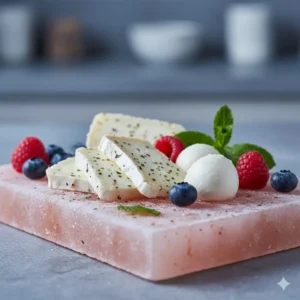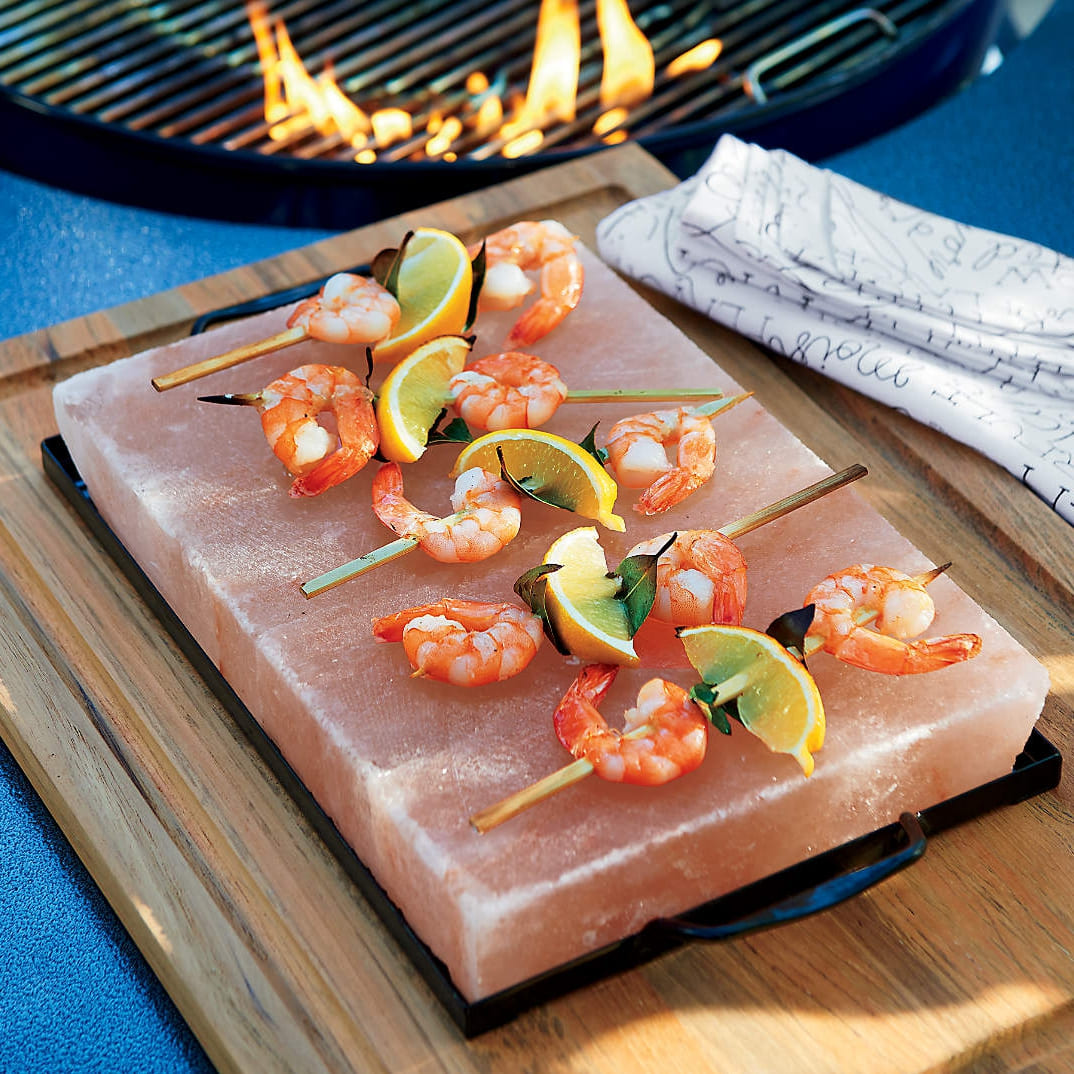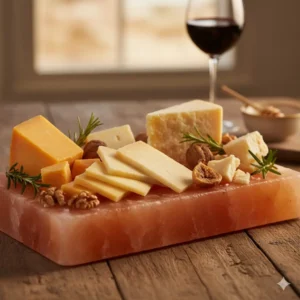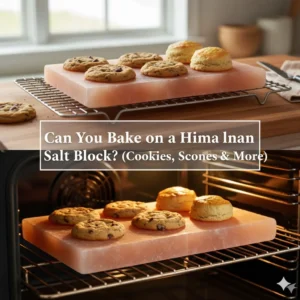A salt block—whether chilled or at room temperature—reshapes how cheese and charcuterie are served and experienced. A chilled block keeps cheese firm, fresh, and lightly seasoned, ideal for warm environments or polished presentations. A room temperature block, by contrast, deepens salt interaction and enhances natural creaminess for a softer mouthfeel. This article outlines how each method influences flavor, texture, and visual impact, helping you select the right serving style for your occasion.

Chilled vs. Room Temperature Salt Blocks: Key Differences at a Glance
Choosing between a chilled or room temperature salt block influences both flavor and presentation. Each method offers a distinct way to serve cheese and charcuterie depending on your setting and the desired guest experience. Use this table to review their main differences and determine which option best suits your entertaining approach.
| Feature | Chilled Salt Block | Room Temperature Salt Block |
|---|---|---|
| Serving Temperature | Cold surface keeps cheese cool, preserving structure and freshness | Ambient surface supports natural cheese texture at room temperature |
| Salt Infusion | Provides gentle, steady salt infusion that enhances mild cheeses | Offers lighter seasoning, maintaining the cheese’s original flavor |
| Visual Appeal | Frosted, refined look with a cool sheen | Natural crystal tone with a warm, organic finish |
| Ideal Cheese Types | Fresh, soft varieties like mozzarella, goat cheese, or ricotta | Semi-hard to hard cheeses such as cheddar, gouda, or manchego |
| Best Use | Ideal for warm-weather entertaining or refined appetizers | Perfect for relaxed, traditional cheese boards |
What Is a Chilled Salt Block?
A chilled salt block is a slab of Himalayan pink salt cooled in the freezer for several hours or overnight before serving. Its natural crystalline structure retains cold efficiently, keeping cheese firm and fresh throughout an event. Chilling also enhances visual presentation, giving the block a refined, translucent sheen that complements modern or classic table settings.

When cheese rests on the chilled surface, it absorbs a delicate layer of salt that enhances flavor without masking natural notes. This light seasoning works particularly well with soft or high-moisture cheeses, creating a balanced taste and texture in a single step. The result is a serving surface that is both functional and sensory, subtly shaping the tasting experience.
Hosts favor chilled salt blocks for their blend of practicality and sophistication. Beyond cheese, they beautifully support full charcuterie arrangements—pairing seamlessly with cured meats, fruits, and nuts while maintaining an invitingly cool temperature for guests.
What Is a Room Temperature Salt Block?
A room temperature salt block is a slab of Himalayan pink salt used at ambient temperature to serve cheese in its natural state. It doubles as both a serving surface and a subtle seasoning medium, providing a delicate trace of salt while highlighting the stone’s organic character and visual warmth.
Unlike a chilled salt block, this approach preserves the cheese’s original flavor and consistency. With no cooling effect, cheeses maintain their natural aromas and mouthfeel, making this style ideal for relaxed tastings, traditional boards, and casual entertaining.
This method is best suited for firmer or semi-hard cheeses that can absorb light salinity without softening. When paired with cured meats or fresh fruits, it delivers a composed presentation that balances texture, flavor, and understated elegance.
Premium Himalayan Salt Blocks for B2B Partnerships
Source authentic pink Himalayan salt blocks, bricks, and plates crafted for culinary, retail, and hospitality clients. Choose from customizable sizes, private label options, and flexible global shipping to enhance your product selection and elevate customer experience.

Choosing Cheese Types for Chilled vs. Room Temperature Salt Blocks
Choosing the right cheese for your salt block hinges on temperature and texture. Chilled and room temperature surfaces influence flavor and mouthfeel differently, making thoughtful pairing essential for a cohesive tasting experience. Matching each cheese to the block’s properties enhances both presentation and balance across any charcuterie board.
Best Cheeses for Chilled Salt Block Serving
A chilled salt block serves as a natural seasoning surface, giving mild cheeses a refined lift in flavor while preserving their structure. Its cool temperature supports texture stability during extended serving times. Soft, high-moisture cheeses respond best to the gentle salinity, maintaining clean flavor and creamy consistency.
- Fresh mozzarella, goat cheese, ricotta, and burrata absorb salt delicately for smooth, balanced bites.
- The moisture in these cheeses prevents excessive salt uptake, keeping textures supple and pleasant.
- Avoid heavily aged or pre-salted varieties, as added salinity can intensify beyond optimal flavor balance.
This approach transforms simple selections into polished, restaurant-quality presentations suited to refined entertaining.

Recommended Cheeses for Room Temperature Salt Blocks
Room temperature salt blocks favor firmer, semi-hard cheeses that retain stability in ambient conditions. These varieties engage steadily with the salt surface, enhancing mouthfeel without altering integrity. The neutral temperature promotes aromatic depth and easy serving for guests.
- Semi-hard cheeses such as mild cheddar, gouda, and manchego develop subtle salt accents while preserving density.
- They complement cured meats and fruit spreads seamlessly, creating rounded, flavor-forward combinations.
- Avoid soft, moisture-rich cheeses in this setting to prevent uneven seasoning and loss of firmness.
Using room temperature blocks accentuates the savory side of cheese while maintaining an inviting, well-balanced presentation for any casual or formal occasion.
Presentation Tips: Enhancing Visual and Flavor Appeal
A chilled Himalayan salt block elevates a cheese platter into an elegant centerpiece suited for refined entertaining. To achieve a balanced and visually dynamic spread, select cheeses of varying textures and colors. The soft pink hues of the salt contrast beautifully with creamy interiors or golden rinds, helping each selection command visual interest on the serving surface.
Accent the arrangement with accompaniments that introduce complementary flavor notes and textures. Fresh figs, grapes, or apple slices lend sweetness, while almonds or walnuts contribute satisfying crunch. A light drizzle of honey ties these elements together, softening the salt’s edge with a subtle gloss and touch of sweetness.
Position condiments such as chutneys or preserves in small bowls beside the salt block, not directly on it, to avoid moisture contact and maintain the block’s polish. Keep crackers nearby on a separate dish to ensure they remain crisp and ready for pairing throughout the gathering.
Care and Maintenance for Salt Blocks After Cheese Serving
Proper care ensures your salt block remains pristine and functional for every cheese or charcuterie presentation. After use, gently remove any residue with a soft, slightly damp cloth—avoid soaking or aggressive scrubbing. This preserves the block’s smooth surface and distinctive pink hue while minimizing salt loss.
Never apply soap or submerge the block in water, as salt dissolves easily. Allow it to air dry completely before storage, then place it in a cool, dry area protected from humidity. With this simple routine, your salt block will retain its structure and subtle flavor-enhancing qualities for many future gatherings.
Frequently Asked Questions About Pairing Cheese with Salt Blocks
Will the salt block make my cheese too salty?
No. A chilled salt block imparts only a light hint of salinity. It seasons the outer layer of the cheese rather than saturating it, maintaining the cheese’s original flavor profile. Softer or high-moisture varieties may absorb a little more salt, resulting in a balanced finish.
How long can I leave cheese on a chilled salt block?
Keep cheese on the salt block for approximately 10–15 minutes before serving. This allows adequate flavor diffusion without compromising texture. When properly chilled, the block also maintains an optimal serving temperature throughout tasting.
Which types of cheese should I avoid serving on salt blocks?
Skip very soft or crumbly cheeses—such as fresh feta or blue varieties—as they may absorb excessive salt. Instead, use semi-firm cheeses like Havarti, Fontina, or mild goat cheese, which hold their shape while taking on refined seasoning from the block.
Is it advisable to serve crackers directly on a salt block?
No. Crackers and bread readily absorb surface moisture, which can compromise their crispness. Serve them on a separate plate beside the salt block to preserve texture and allow guests to build combinations to their taste.
What is the best way to clean a salt block after serving cheese?
Allow the block to reach room temperature before cleaning. Wipe it gently with a damp cloth or sponge—avoid soap and soaking, as salt dissolves easily. Once completely dry, store it in a cool, dry location to maintain its durability for future use.
Final Thoughts
Serving cheese on a chilled salt block offers a refined balance of flavor and texture. The cool surface preserves freshness and gently seasons mild varieties, adding subtle complexity without overshadowing their natural character. It’s an elegant choice for fresh cheeses and occasions where visual presentation complements taste.
For firmer cheeses, a room temperature salt block maintains structure while imparting only a light touch of salt. Either approach turns the block into both a serving platform and seasoning instrument—enhancing pairings and elevating the overall tasting experience.
Consider the cheese varieties, the atmosphere of your event, and the impression you want guests to take away. Selecting the right temperature transforms a simple platter into a curated experience that feels deliberate and memorable.






